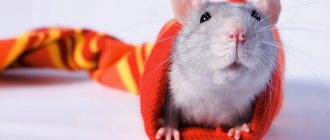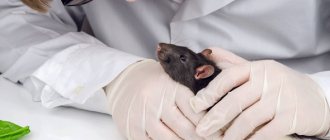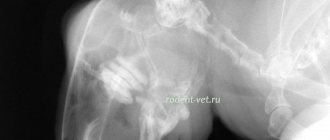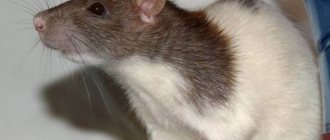Causes of an abscess
An abscess is a purulent disease that occurs in various tissues, organs, muscles and bones. It can be internal and external.
The causes of an abscess on the body of a decorative rat include:
- bites;
- scratches;
- wounds;
- other causes of damage to the integrity of the skin.
Dangerous bacteria penetrate into an open wound, causing an inflammatory process, as a result of which the animal’s immunity decreases and pus accumulates.
Important! The owner of a pet can also infect it with staphylococcus found on human skin.
Symptoms of the disease
The main signs that your pet has a cold include the following:
- loss of appetite or complete refusal to eat;
- apathy and lethargy;
- refusal to brush wool;
- dullness and ruffled fur;
- causeless aggression, nervousness, increased excitability;
- mucous or mucopurulent discharge from the nose and eyes;
- cough, sneezing, runny nose.
If you notice the first symptoms of the disease, for example, sneezing or refusal to eat, the animal should be taken to the veterinarian immediately. If the cold develops into pneumonia, the rat will live no more than four days.
It is important to remember that only a qualified veterinarian can make an accurate diagnosis and prescribe effective treatment. Any attempts at self-medication will most likely end in failure and lead to the death of the animal.
Main features
A timely detected subcutaneous abscess on a rodent's body will help save the life of a pet.
This disease can be recognized by the following signs:
- the rat’s behavior changes - it becomes lethargic, sleepy, and inactive;
- First, at the site of abscess formation, the skin turns red, later swelling occurs;
- the skin on the abscess becomes thinner and becomes covered with scabs;
- When opened, the resulting inflamed capsule is filled with yellow or green pus, emitting a rotten smell.
Where can it occur
The occurrence of an abscess on the body of a rat is fraught with various consequences. The purulent contents of the capsule can break out both outside (mild course of the disease) and inside the body (severe course). The location of the malicious source is also important.
Did you know? The rat's teeth are so strong that they can chew through concrete and iron.
An abscess appears in the following places:
- in the oral cavity near the roots of the teeth;
- on the neck;
- behind the ears;
- on the limbs;
- on the stomach;
- on the sides;
- in males in the groin area;
- behind the eyes.
The most dangerous are the ulcers formed on the animal’s head.
Localization
An abscess can occur on absolutely any part of the animal’s body:
- oral cavity – bring severe discomfort, disrupting the usual way of life, and are marked by severe pain;
- groin - in males;
- head - ears, neck;
- body – sides, limbs, belly, withers;
- eyes - formation in this place may indicate the presence of tumors on the brain, as well as a rapid decrease in immunity.
On the neck
The location of the abscess in this place is very dangerous, and opening it is permissible only in a hospital setting, because the abscess is located near the passage of large vessels and lymph nodes. Ignoring an abscess in this place is fraught with the rapid development of sepsis.
A tumor that arises in this place can be either benign or malignant, so the doctor makes the decision on what to do best to save the life of the animal after collecting the puncture and on the basis of histological and cytological examination of the contents of the tumor.
In addition to abscesses located in the neck, tumors located in the mouth and near the eyes should also be observed by a doctor. Self-treatment in these cases is unacceptable.
Treatment of abscesses in rats at home
It is necessary to treat ulcers in veterinary hospitals, since a minor surgical operation is performed, known only to a specialist. It includes: the use of local anesthesia, opening the abscess, washing it, suturing (if the wound is large and deep), postoperative care, etc. But if the decorative pet has a small source of pus on the soft tissues, except for the cervical, eye and dental, then this procedure can be carried out independently at home.
Important! To avoid re-infection, you can give your pet injections with antibiotics prescribed by your veterinarian.
To do this you need:
- Wash your hands thoroughly with soap.
- Carefully remove hair from the abscess site.
- Soak the resulting crust on the swelling with warm water and remove.
- Gently press on the base of the abscess, trying to direct the movement of pus outward rather than inward.
- Remove bloody discharge with a cotton swab until it is completely gone.
- Rinse the wound thoroughly with 1% Chlorhexidine solution and 9% saline solution.
- Dry with a sterile cloth.
- Lubricate with Levomekol ointment or Tetracycline ointment.
- Regularly treat the wound with antiseptic agents until it is completely healed.
Chronic respiratory syndrome (mycoplasmosis) of rats and other mouse-like rodents
It is not news to lovers of decorative rodents that the most common disease of internal organs in rats (besides oncology) is diseases of the respiratory system. In veterinary medicine, diseases of the respiratory system of rats (and other mouse-like rodents close to them - various types of ornamental mice, gerbils) are referred to as chronic respiratory syndrome of mouse-like rodents (CRS) . This disease is often called mycoplasmosis (after the name of one of the causative agents of the disease, mycoplasma pulmonis). Features of rat physiology. - The average lifespan of rats is 1.5-2.5 years. Some “long-livers” live up to 3-3.5 years. Rats that are 5 or 7 years old are a myth. — rats are conventionally considered “middle-aged” after they reach the age of 1 year. Chronic respiratory syndrome is a disease of rats of all ages (but mainly older than 1 year), caused by a group of pathogens (mycoplasma, bordetella, pasteurella, streptococcus, sendai virus), manifested by respiratory (breathing disorders) and other symptoms (the reproductive system may be involved in the pathological process , skin, hearing organs, vestibular apparatus). It is believed that rats are lifelong carriers of these pathogens, primarily mycoplasma (microorganisms “live” on the mucous membrane of the respiratory tract of apparently healthy animals). The cause of the development of the disease is a variety of environmental factors and the state of the body (primarily the immune system) of a particular rat. When conditions favorable for microorganisms arise, their numbers sharply increase and spread throughout the rat’s body, which leads to a deterioration in the pet’s condition and the development of pronounced clinical signs. It is believed that it is impossible to completely cure a rat from CRS (mycoplasmosis). Therefore, the actions of a veterinary specialist are aimed at eliminating the identified clinical symptoms of the disease and restoring the comfort of the animal’s life.
Altered rabbit molars
The main symptoms of CRS: Respiratory form - lethargy and loss of appetite. - shortness of breath and sounds when breathing. - discharge from the eyes and nasal passages of the red pigment of the Harderian gland - porphyrin (usually they say that the rat has “porphyrinitis”). - sneezing. Other forms of the course that usually accompany the respiratory one: Skin – itching, scratching, sores and crusts on the skin. This condition is caused by the toxic effect of a rapidly increasing colony of pathogen (mainly mycoplasma) on the body. This condition should be distinguished from other skin diseases accompanied by itching (primarily mite infestation). Damage to the middle/inner ear and vestibular apparatus is characterized by a violation of the position of the head (tilt to the right or left) and/or impaired coordination of the animal up to a complete loss of support on the limbs, forced posture and rotational movements around its axis. Similar symptoms occur with the development of tumors in the pituitary gland (part of the brain) in non-sterilized female rats. Unfortunately, it is difficult to distinguish between these diseases (without the use of MRI methods) even posthumously (during a pathological autopsy). Damage to the reproductive system of females in the form of an inflammatory process on the mucous membrane of the uterus, accompanied by bloody or bloody-purulent discharge from the vagina.
forced pose
Stages of respiratory syndrome. 1 – Absence of clinical symptoms (carriage, latent stage). The animal shows no signs of the disease. 2 – The first signs of respiratory syndrome. Usually characterized by slight release of porphyrin, sneezing, while maintaining appetite and general activity. 3 – Severe clinical picture (multiple organ failure). There are various, pronounced symptoms of respiratory failure, as well as other symptoms, depending on the form of the disease (impaired coordination, copious hemorrhagic vaginal discharge, crusts on the skin, unnatural posture of the animal). 4 – Terminal is manifested by general weakness, a sharp decrease in activity, a drop in body temperature, and exhaustion. The animal is in a preagonal state. This condition ends in the death of the rat.
Treatment of respiratory syndrome consists of the use of antibiotics that work against mycoplasma and accompanying microflora, as well as symptomatic therapy (oxygen chamber for shortness of breath, diuretics, drugs that dilate the lumen of the bronchi, etc.). If there is no effect from antibiotic therapy in mono mode, hormonal drugs are also added. Depending on the form and stage of the disease, it is necessary to make a decision on the initiation of certain therapeutic measures. To put it simply, the question comes down to the decision to start using a course of antibiotics or an antibiotic-hormone combination. The list of antibiotics used (effective against mycoplasma, also acting on other microflora, and not having an acute toxic effect on the rodent’s body) is not very long. Therefore, it is recommended to begin treatment for CRS at the moment the disease transitions from stage 2 to stage 3, i.e. at the moment of the appearance of a pronounced clinical picture and significant manifestation of one of the forms of the disease. At stage 1 and, most often, stage 2, general measures to counteract the disease are recommended: proper, varied, nutritious feeding, herbal medicine (echinacea decoction), exercise, keeping small groups in spacious cages with the possibility of physical activity (running wheels, tubes, large cage sizes, floors in cages).
result" of sterilization operation
If there are signs of damage to the reproductive system (bloody, purulent, bloody-purulent vaginal discharge, acute vaginal bleeding), the only effective treatment is surgery to remove the reproductive system (ovariohysterectomy/sterilization of the female). This operation can only be performed on clinically stable animals, against the background of antibiotic therapy. The use of gas (inhalation) anesthesia significantly reduces anesthetic risks for a weakened and, most often, older animal. Sterilization of female rats at an early age (3-4 months) is one of the methods for preventing this form of mycoplasmosis. Severe skin itching is eliminated by the use of long-acting corticosteroid drugs. Treatment of internal otitis is unpromising. Most often, after completing a course of antibiotics and hormones, symptoms quickly recur.
Drugs: Fluoroquinolone antibiotics In veterinary practice this is: Ciprofloxacin in tablet form (honey or vet). Enrofloxacin is a veterinary drug in the form of a 2.5% solution for injection (Baytril, Enroflon, Enrosept, Enronil, Enronit, etc.). Tylosin is a veterinary antibiotic, in the form of an injection solution (tylosin, farmazin). Doxycycline is a medical product, in capsules or suspension (doxycycline, Unidox). Azithromycin is a medical powder for oral administration diluted in water (azithromycin, sumamed). Ceftriaxone is a medical solution for intramuscular injection (ceftriaxone). Marbofloxacin – veterinary, solution for injection (marbocil, marboxil). Hormonal drugs - dexamethasone, prednisolone, metypred, depomedrol. All medical drugs are available in the form of tablets and injection solutions.
Veterinarian Tatyana Sergeevna Semirotova
Veterinarian Artem Arkadievich Kazakov
Aftercare
Opening an abscess for a decorative rat is a serious operation that requires further care for the animal’s rapid recovery.
It is as follows:
- antiseptics can be used no more than once a day;
- isolate the sick rodent from other pets;
- provide him with adequate nutrition and plenty of fluids to restore strength, and also introduce probiotics into the diet to normalize the intestinal microflora after taking antibiotics;
- clean the cage with the rat every day, avoiding any unpleasant odor in it.
Also learn how to identify and treat mycoplasmosis in a rat.










